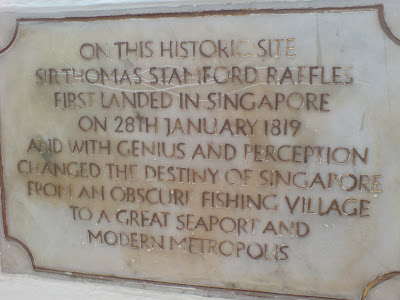1. Raffles' Landing Site (by Leonard)
This is the starting point of our heritage trail. Situated along the Singapore River, this was stipulated to be the official landing site of the much renowned Sir Stamford Raffles. At this place, the statue of Raffles stands tall in its white pristine look, overseeing the land mass of the island of Singapore.
Standing tall and looking smart...


The wide acceptance and adulation of the colonizer is evident in what was inscribed on the statue of Sir Raffles. “This tablet to the memory of Sir Stamford Raffles whose foresight and genius Singapore owes its existence and prosperity.” Indeed it is interesting to note that our prosperity and success of Singapore today is not attributed to the years of nation building and the contributions of our early founding fathers of out little nation state but rather solely placed on the little shoulders of the coloniser. It seems to suggest that Sir Stamford Raffles was solely responsible for being a catalyst whose colonisation of this little island has set in motion for the island to grow into what it become today. Knowingly or unknowingly, this has let the idea that “Singapore was nothing before Raffles”.
This openly lavish adulation of a coloniser has a profound impact to the history of a nation. History itself is a study, it is open to interpretation by scholars who do research on such issues and finds. Yet, what shapes one’s interpretation and understanding of something that is as open as history is in one’s inherent mindset, culture and upbringing.
Thus it is dangerous to openly praise a colonizer, given that since such works and such “official” history are widely sanctioned by the government, people tend to accept it as truth. Intellectuals who thus study the artefacts and archaeological digs are hamstringed by the earlier “official” school of thought and their belief in it. This may result in inaccurate interpretations of events in history that may in the end give a skewed account of the country’s history.
However, whether this has resulted in the skewed idea of early/ancient Singapore history, it is uncertain. Records are unclear whether the lands mentioned in those records referred to the island of Temasek(what Singapore was known as back then) but archaeological finds tend to point towards Singapore as a fairly advanced civilisation back in the ancient times.
Scholars and intellectuals as well as history students still ponder over this question, was Singapore a mere fishing village before colonisation? This question still awaits an answer. Yet what can be sure is that the open adulation of Raffles’ Colonising of Singapore undoubtedly leaves a deep impact on the history of this nation.
Raffles wannabes...


Next up, we shall move on to the Asian Civilisations Museum @ Empress Place...




No comments:
Post a Comment